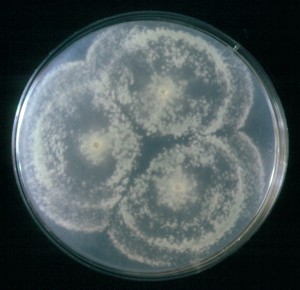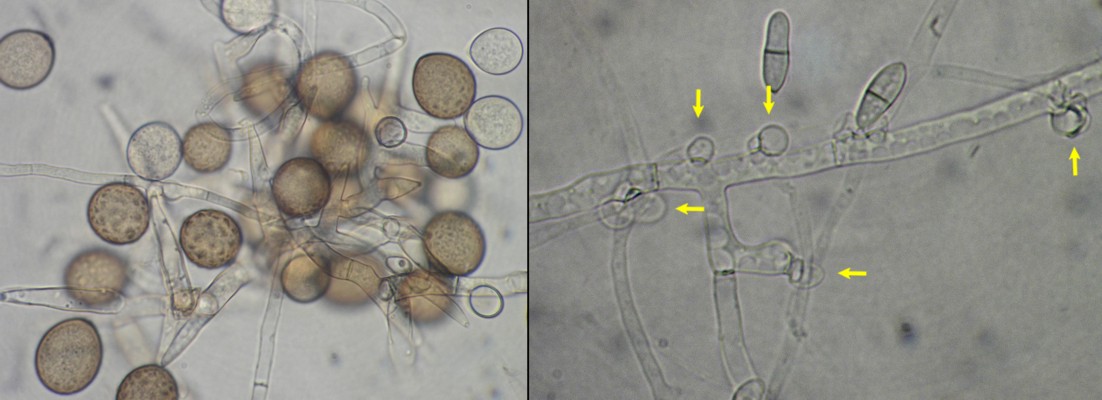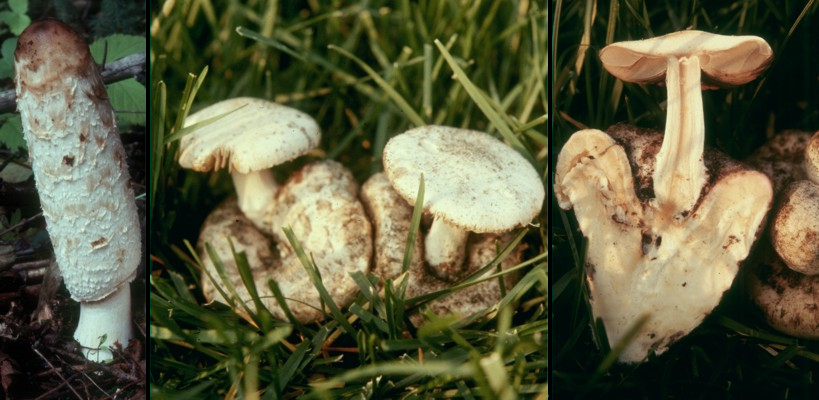Home >> Where fungi grow >> Parasites >> Fungi parasitic on other fungi
FUNGI PARASITIC ON OTHER FUNGI
Although this may sound surprising, fungi are often parasitic on other fungi. In fact, mycoparasitism is common among fungi, with whole groups specialized for this way of life. We can view mycoparasites in much the same way we do plant parasites, that is as necrotrophs and biotrophs. Necrotrophs kill the tissues they will consume while biotrophs obtain nutrition from living tissues.

Necrotrophic mycoparasites, like the species of Trichoderma at right can be extremely destructive to other fungi. They often spread rapidly, completely surrounding and covering their hosts in a few hours or days. The mechanisms used by necrotrophic mycoparasites to kill their hosts are not thoroughly studied but probably involve toxins as happens with necrotrophic plant parasites. Trichoderma, the most frequently studied mycoparasite occurs in soils, rotting wood, old mushrooms and many other environments. When it grows over another fungus it simply dissolves its host's hyphae with extracellular enzymes. This phenomenon can be interesting to observe. If a piece of a colony of a Trichoderma species is placed on the colony of another fungus, allowed to grow for a few hours and then placed under a microscope you will easily be able to see the hyphae of both fungi. However, a few days later the same examination will reveal only Trichoderma, looking healthy and vigourous. Trichoderma species are not usually very particular about what fungi they will consume. This lack of host-specificity has made them useful as agents of biological control for plant parasites, especially those attacking roots. On the other hand, these same fungi can be highly destructive if they get into into commercial mushroom beds.

Biotrophic mycoparasites appear to be less destructive to their hosts and to remain active as long as the host is active. Most biotrophs obtain nutrients from their host via specialized cells, usually either contact cells or haustoria. Contact cells, the most common means of biotrophic mycoparasitism, are small sucker-like cells that are attached to the surface of a host hypha. Connection between the two is by means of a small pore. Haustoria, found in certain mycoparasitic Zygomycota, are a kind of absorptive cell produced inside the hyphae of the host. Biotrophic mycoparasites are very widespread but their parasitic nature may not be obvious. If two fungi are found growing together there is a great likelihood that one of them is a parasite. However it requires careful experimentation to demonstrate parasitism in fungi and much work has yet to be done before scientists have a clear understanding of its extent. The picture above is of Harzia verrucosa, a common biotrophic parasite of fungi growing in dead seaweed along our coasts. The left panel shows the typical egg-shaped roughened spores of H. verrucosa while the right one shows the narrow hyphae of H. verrucosa connecting to a broader hypha of Paradendryphiella salina by means of swollen contact cells, indicated by the yellow arrows.

A more spectacular form of mycoparasitism can be seen in the group above. In the left panel is the shaggy mane mushroom Coprinus comatus as it is commonly seen in many parts of the world. It consists of a cylindrical to egg-shaped shaggy cap supported by a smooth stalk. The central panel shows two shaggy manes that have been deformed into funnel-shaped objects, each bearing the mushroom Psathyrella epimyces, a mycoparasite specializing in shaggy manes. The right panel is of an infected shaggy mane that has been cut in half to show the parasite growing up from it. There are several mycoparasitic mushrooms known, each attacking a particular group of hosts. None of these has been studied carefully and it is not known whether they are necro- or biotrophic parasites, although it is likely they are biotrophs.